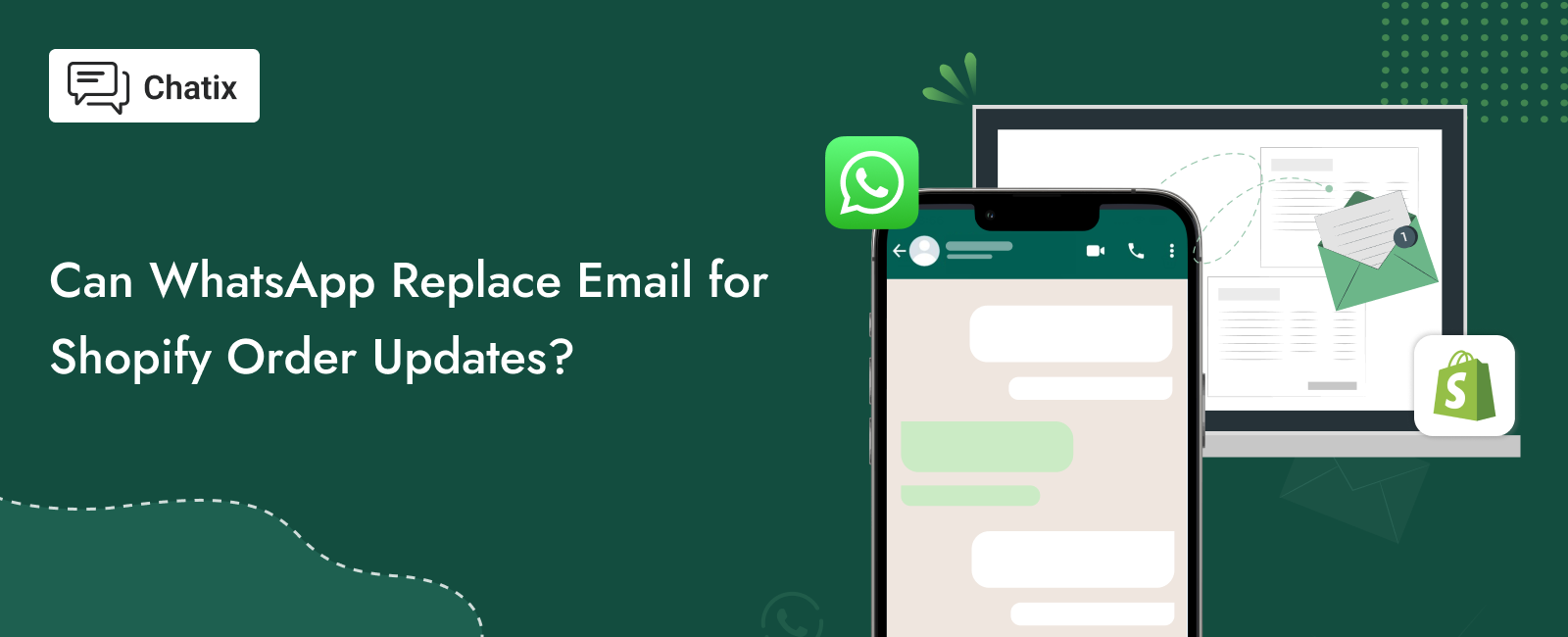
Can WhatsApp Replace Email for Shopify Order Updates?
WhatsApp Marketing Published: September 12, 2025
Keeping customers informed about their orders is one of the most important parts of running a successful Shopify store. Traditionally, email has been the go-to method for sending order confirmations, shipping updates, and delivery notifications. But times are changing.
With billions of users and instant reach, WhatsApp is changing the way eCommerce businesses, including Shopify stores, connect with customers. Its instant, personal, and highly engaging nature has many Shopify merchants asking:
👉 Can WhatsApp replace email for sending order updates?
Let’s break down the advantages, challenges, and practical ways WhatsApp could step into the role email has held for years, and how Shopify stores can use them to deliver the best possible customer experience.
Why Order Updates Matter So Much?
Think about the last time you ordered something online. The first thing you wanted after paying was reassurance—“Did my order go through?” After that, you probably checked for:
- A confirmation message 📩
- Shipping updates 🚚
- Delivery notifications 📦
If you didn’t get those updates, you likely felt anxious or frustrated. That’s exactly how customers feel when stores fail to communicate properly. Timely updates build trust and satisfaction, while poor communication often leads to negative reviews or repeat inquiries to customer support.
Traditionally, email has handled this role. But with today’s fast-paced digital habits, many customers don’t check email as often—or may miss your messages entirely. This is where WhatsApp comes in.
Related Reading: WhatsApp Marketing vs Traditional Marketing
WhatsApp vs. Email: A Quick Comparison
Here’s how WhatsApp compares with email when it comes to Shopify order updates:
1. Open Rates
- Email: Average open rates hover around 20–25%. Many emails go unopened.
- WhatsApp: Open rates reach 90–95%, often within minutes of sending.
2. Speed of Delivery
- Email: Delivers in seconds but may get delayed by filters or server issues.
- WhatsApp: Instant delivery, with a high chance of customers reading it quickly.
3. Customer Engagement
- Email: Works for formal communication but often feels impersonal.
- WhatsApp: Feels personal, conversational, and more engaging.
4. Personalization
- Email: Can be personalized with names and order details, but usually feels formal.
- WhatsApp: Offers a chat-like experience with personalized updates, reminders, and even product suggestions.
5. Flexibility
- Email: Perfect for detailed content like receipts, invoices, or long instructions.
- WhatsApp: Best for short, timely updates like confirmations, shipping notices, and delivery alerts.
6. Reliability
- Email: Sometimes delayed, filtered, or ignored.
- WhatsApp: Direct-to-phone delivery makes it highly reliable.
Benefits of Using WhatsApp for Shopify Order Updates
If you’re considering WhatsApp, here are the key benefits:
- Higher Visibility
- Real-Time Support
- Better Customer Experience
- Reduced Cart Abandonment
- Two-Way Interaction
Your customer doesn’t need to dig through an inbox. WhatsApp messages show up as notifications, ensuring updates are seen right away.
Customers can reply directly if they have questions like, “When will my order arrive?” or “Can I change my address?” This reduces support tickets and builds trust.
Customers love updates they don’t have to hunt for. A quick WhatsApp message reassures them that everything is on track.
WhatsApp reminders can encourage customers to complete a purchase if they leave items behind, something that often gets lost in email.
Unlike email, WhatsApp is naturally conversational. Customers can reply to confirm details, ask about delivery, or get support—all in one place.
Also read: How to Create a WhatsApp Sales Funnel?
Challenges of Replacing Email with WhatsApp
While WhatsApp has big advantages, it may not fully replace email in every case. Here’s why:
- Message Limits
- Professional Documentation
- Customer Preference
- Scalability
WhatsApp has rules about the type and number of business messages that can be sent, especially if they’re promotional. You need approved message templates for updates.
Email still works better for sending detailed invoices, receipts, or policies. Customers may prefer these for record-keeping.
Not everyone may want business messages on WhatsApp. Some customers still prefer email to keep personal and business communication separate.
For large-scale updates or marketing campaigns, email remains more flexible for handling bulk sends without restrictions.
Smart Approach: Use WhatsApp and Email Together

Instead of choosing one over the other, Shopify merchants can use both channels strategically. Use WhatsApp for:
✅ Order confirmations
✅ Shipping and delivery notifications
✅ Abandoned cart reminders
✅ Quick customer support
Use Email for:
📩 Detailed invoices and receipts
📩 Newsletters and promotional offers
📩 Long-form content (e.g., product guides, policies)
This way, you cover all customer preferences while improving speed and visibility from WhatsApp, plus documentation and flexibility from email.
Practical Tips to Get Started with WhatsApp Order Updates
If you’re ready to bring WhatsApp into your Shopify store, here are some practical steps:
- Get Customer Opt-In
- Verify your Business
- Use Whatsapp Message Templates
- Automate with Shopify Apps
- Keep it Balanced
Always ask customers if they’d like to receive updates via WhatsApp. You can add this option at checkout.
A green tick on WhatsApp adds credibility and ensures customers know they’re chatting with your official business account.
Prepare templates for order confirmations, shipping notices, and delivery updates. Keep them short, friendly, and professional.
Tools like Chatix make it easy to automate WhatsApp updates so you don’t have to send them manually.
Don’t overwhelm customers with too many messages. Send only the most important updates to keep the experience positive.
Real-Life Example
Let’s see how this works in action.
Scenario: A customer buys a dress from your Shopify store.
Immediately, they get a WhatsApp message:
The next day:
On delivery day:
This creates a smooth, reassuring experience that email alone often fails to deliver.
Conclusion
So, can WhatsApp replace email for Shopify order updates? The short answer: not completely—but it can definitely take the lead.
WhatsApp is faster, more personal, and far more effective for quick updates. Email still has its place for formal, detailed, or large-scale communication.You can also check out the most useful email formats for online stores.
For the best results, Shopify merchants should use both together. This way, you ensure your customers never miss important updates, enjoy a smooth shopping experience, and stay connected with your brand in the way they prefer.
In the end, it’s not about choosing one over the other—it’s about building a communication strategy that customers love. And when customers feel informed and cared for, they’re far more likely to come back and shop again.
Frequently Asked Questions
1. Can WhatsApp replace email for Shopify order updates?
Not fully. WhatsApp is faster and more engaging, but email is still useful for invoices, receipts, and detailed communication.
2. Why is WhatsApp better than email for order updates?
WhatsApp has higher open rates (90%+) and delivers instant notifications, making it more reliable than email for quick updates.
3. Should I use both WhatsApp and email for Shopify orders?
Yes. Use WhatsApp for confirmations, shipping, and delivery updates, and email for invoices, policies, and long-form details.
4. How do I send Shopify order updates on WhatsApp?
You can use Shopify WhatsApp apps like Chatix to automate order confirmations, shipping alerts, and abandoned cart reminders.
5. Do customers prefer WhatsApp or email for order updates?
Most customers prefer WhatsApp for real-time updates but still expect email for formal records like receipts or warranties.

